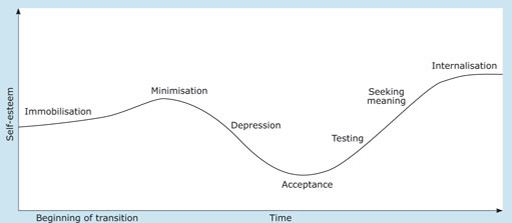7.1 Making the transition
Seven stages of transition have been identified which apply to management and indeed many other life and work transitions, especially when a transition has been quite sudden (Adams et al., 1976). These are set out below.
- Immobilisation: the initial ‘frozen’ feeling when you do not know what to make of your new role.
- Minimisation: you carry on as though nothing has changed, perhaps denying inside that you really have new roles as a manager.
- Depression: when the nature and volume of the expectations upon you have sunk in and you feel you cannot cope; depression can be accompanied by feelings of panic, anger and blame.
- Acceptance: when you begin to realise there are things you are achieving and more you could achieve, and that you have moved on from what you used to do.
- Testing: when you begin to form your own views on what management is all about and even experimenting with what you can do.
- Seeking meaning: you find the inclination and energy to reflect upon and learn from your own and others’ behaviour.
- Internalising: you define yourself as a manager, not just in title but in what you think you are doing; you and your job have come to terms with each other.
The seven transition phases represent a sequence in the level of self-esteem as you experience a disruption, gradually acknowledge its reality, test yourself, understand yourself, and incorporate changes in your behaviour. Changes in level of self-esteem appear to follow a predictable path. Identifying the seven phases along such a self-esteem curve can help you to understand the transition process better. This is illustrated in Figure 3.
Although this seven-stage model describes transition as a sequence, not everyone in job transition will experience every phase. Each person’s progress is unique: one may never get beyond denial or minimisation; another may drop out during depression; and others will move smoothly and rapidly to the later phases.

